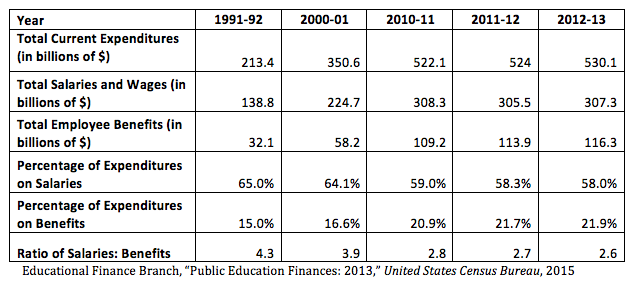
The Census Bureau’s annual Public Education Finances compiles total education spending and revenue across the entire country. The latest data shows teacher benefits continue to chip away at school budgets.
Public school expenditures have more than doubled since 1992 (including inflation), and the percentage of those funds spent on teacher benefits has increased as well. The percentage spent on teacher salaries, however, has dropped. The table below captures various education expenditures* by all public schools across the country over time.
Employee benefit expenditures include costs such as retirement plans and health insurance. School district expenditures on benefits leapt over 99 percent since the early 2000s, and climbed steadily over the past three years, now taking up nearly 22 percent of the budget. Spending on salaries increased by just 37 percent during this same window.
As a share of total expenditures, benefits are also increasing and they now eat up five percentage points more than in 2001. Over the same time period, the percentage spent on teachers’ day-to-day wages has declined, down over six percentage points since 2001.
The changing ratio of salaries to benefits is troubling. Increasing spending on benefits saps already limited funding, and prevents districts from taking on new teachers or rewarding experienced ones with raises. A low starting salary could also serve as a deterrent to those considering the teaching profession and could potentially keep talented new graduates from pursuing teaching roles.
*Note: Data do not include capital costs or debt, just current spending
